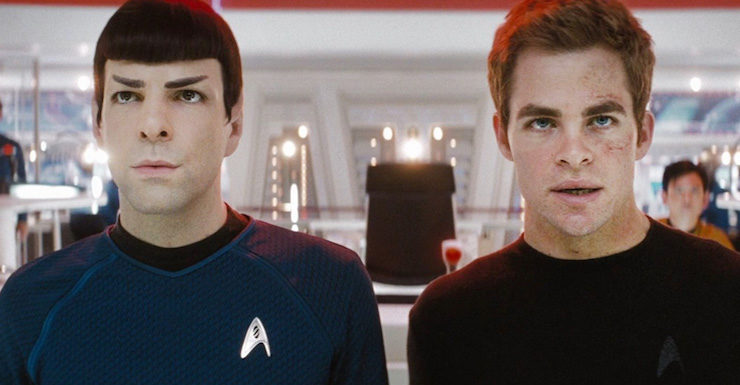Star Trek
Written by Roberto Orci & Alex Kurtzman
Directed by J.J. Abrams
Release date: May 8, 2009
Stardate: 2258.42
Captain’s log. The U.S.S. Kelvin is sent to investigate a peculiar spatial phenomenon, and as they approach, a gigantic ship, the Narada, comes through it and immediately fires on the Kelvin and pounds the crap out of it. At the request of the Narada‘s captain, a Romulan named Nero, Captain Robau takes a shuttle to the Narada to discuss surrender terms. Robau leaves Lieutenant George Kirk in command with orders to evacuate the ship if he doesn’t report in fifteen minutes.
Nero asks if Robau recognizes a particular ship or the face of Ambassador Spock. Robau recognizes neither, but it’s not until Robau gives the date that Nero loses his temper and kills him.
The Narada fires on the Kelvin. George is forced to stay on the bridge, as autopilot is non-functional, and he needs to use the Kelvin to protect the shuttles—on one of which is his very pregnant wife Winona, who gives birth to their son while escaping on one of the shuttles. The last thing he hears is his son being born, and they name him James Tiberius after both their fathers.
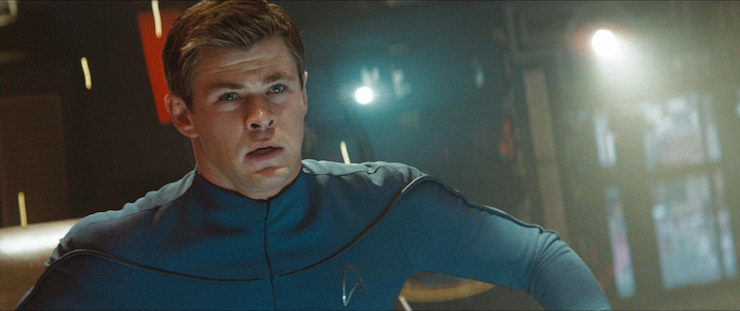
The Kelvin collides with the Narada, destroying the former and leaving the latter adrift while the shuttles escape.
Jumping ahead a decade or so, we look in on a young Jim Kirk, who has stolen his stepfather’s antique Corvette convertible and driven it over a cliff, barely saving himself, and then is stopped by the police. On Vulcan, a young Spock is tormented by his classmates after his lessons. This is their 35th attempt to elicit an emotional response, and it works this time after they call his mother a human whore, thus proving the universality of “yo mama!” as an effective insult.
Years later, Spock goes before the Vulcan Science Academy to see if he will be accepted, though he has also applied to Starfleet Academy to keep his options open. He is praised for accomplishing so much despite the disadvantage of his human mother, which prompts Spock to metaphorically flip them off and head off to Starfleet, to Sarek’s obvious displeasure.
At a bar in Iowa, Cadet Uhura orders drinks for her friends and is hit on by a drunk Kirk. Her fellow cadets pick a fight with Kirk, calling him a townie, and he gets his ass kicked, until they’re stopped by Captain Pike. Pike kicks the cadets out of the bar, and then he talks to Kirk—he did his dissertation on the Kelvin’s fate, and he admires George’s career. He challenges Kirk to enlist in Starfleet, having seen his aptitude tests (which are off the charts). Kirk evinces no interest, at least at first.
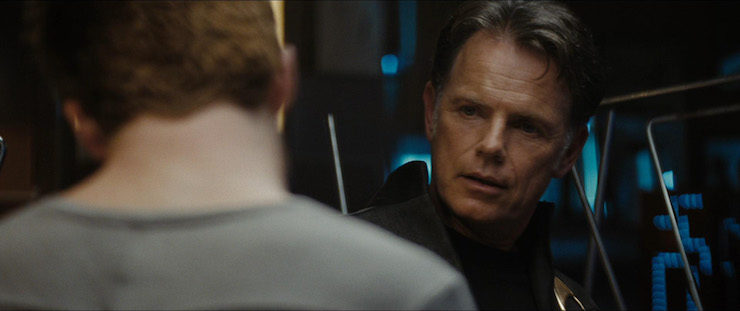
But the next day he gets on the shuttle for new recruits, seated next to McCoy, fresh off his divorce and finding himself with nowhere to go but Starfleet.
Three years later, the Narada arrives at a set of coordinates and a ship flies through another spatial anomaly just like the one the Narada came through twenty-five years earlier, carrying Ambassador Spock.
Kirk tells McCoy he plans to take the Kobayashi Maru test an unprecedented third time, then visits Gaila, a fellow cadet, in her dorm room, until their mad, passionate nookie-nookie is interrupted by Uhura, her roommate. Uhura mentions a Klingon armada that was wiped out at a Klingon prison planet. That’s probably important-ish.
Kirk is able to destroy the Klingon ships menacing the Kobayashi Maru and rescue the latter’s crew, thus beating the simulation, which, we discover, was written by Spock, who’s mildly peeved. Kirk is brought before a review board, where he and Spock have it out with regards to no-win scenarios.
However, they’re interrupted by a distress call from Vulcan. The primary fleet is engaged elsewhere, so cadets are assigned to the ships on Earth, the Enterprise under Pike among them. Spock is Pike’s first officer, and while Uhura is initially assigned to the Farragut, she bullies Spock—her boyfriend—into putting her on Enterprise. (He put her elsewhere to avoid the appearance of favoritism.) Kirk isn’t assigned anywhere due to being on academic suspension, but McCoy gives him symptoms of a virus so he can bring him on board as his patient.
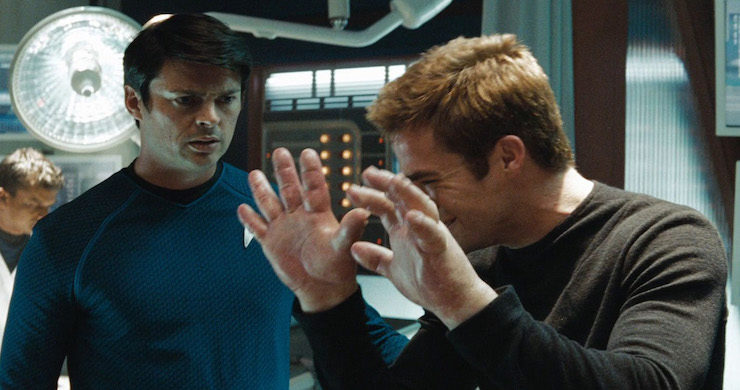
The fleet heads to Vulcan, which is reporting disastrous seismic activity. The Narada is drilling a huge hole in the planet with a particle beam, which also neutralizes communications and transporters. The Enterprise is lagging behind because Sulu—filling in for the ill alpha shift helmsman—forgot to reset the inertial dampeners before going to warp.
Kirk convinces Pike that it’s an attack, not a natural disaster, based on both the Klingon report Uhura translated and what happened to the Kelvin on the day he was born. Spock and Uhura (reluctantly) back him up. Because the dude at communications can’t tell the difference between Romulan and Vulcan, Uhura is assigned to bridge communications, but she doesn’t pick up any transmissions—not from the fleet, either.
They come out of warp into a disaster area, as the wreckage of the rest of the fleet is littering Vulcan’s orbit. Nero holds back from destroying the ship once he realizes it’s Enterprise. He hails them, taunting Spock (to Spock’s abject confusion), and then gives the same terms to Pike that he gave to Robau two-and-a-half decades earlier. Pike agrees to shuttle over, but he assigns Kirk, Sulu, and Chief Engineer Olson to take a shuttle to Vulcan to disable the drill, thus restoring communications and transporters, and then they’ll be able to rescue Pike.
Pike also promotes Kirk to first officer for reasons known only to the voices in his head, and leaves Spock in charge of the ship. They take off in the shuttle, with Kirk, Sulu, and Olson doing a HALO jump to the drill from Pike’s shuttle. Olson waits too long to open his chute and falls off the drill and is vaporized by the particle beam.
Kirk and Sulu land safely (barely), and two Romulans attack. Sulu takes care of both of them with his sword (Kirk just gets his ass kicked). However, the drill has done its job of getting through to Vulcan’s core, at which point Nero tosses a bit of red matter into the big hole. It will create a singularity within Vulcan, destroying it. He also retracts the drill, so Kirk and Sulu are now plummeting to their deaths. Thanks to Chekov’s mad transporter skillz, they’re beamed back. Spock beams to Vulcan to rescue the people (his parents among them) who are in the katric ark, through which transporters and communications cannot penetrate. He is unable to save Amanda, however, who is killed as the planet is destroyed.

Uhura tries to comfort Spock, and they share a kiss in the turbolift.
Nero has imprisoned Pike, and tries to get the subspace codes for Earth’s protective grid. Pike refuses. Nero says that Romulus was destroyed and the Federation did nothing—Spock did nothing. Pike has no idea what he’s talking about since as far as he knows, Romulus is still intact.
Spock orders Sulu to rendezvous with the rest of the fleet. Kirk insists that they pursue Nero before he destroys Earth, which is what he’s on course for. Their argument gets heated, and Spock has security take Kirk away—which he resists, so Spock neck-pinches him and puts him off the ship onto the ice planet of Delta Vega. Kirk heads for the Starfleet outpost on the world, and is almost eaten by a couple of different native animals before he runs into a cave and is saved by Ambassador Spock.
The ambassador mind-melds with Kirk and reveals the whole story: a supernova was endangering the galaxy in the late 24th century. Spock destroyed it by using red matter to create a black hole, but he could not do so before Romulus was destroyed. Nero arrived with the Narada to exact revenge on the ambassador for the death of his family on the homeworld, but both Spock’s ship, the Jellyfish, and Nero’s fell into the black hole and traveled back in time. Nero traveled farther back, and so he had to wait for the Jellyfish to come through 25 years later. Nero took the red matter from Ambassador Spock and used it to destroy Vulcan while the ambassador watched.
Kirk is also devastated to learn that in Ambassador Spock’s timeline, Kirk’s father lived and saw his son take command of the Enterprise.
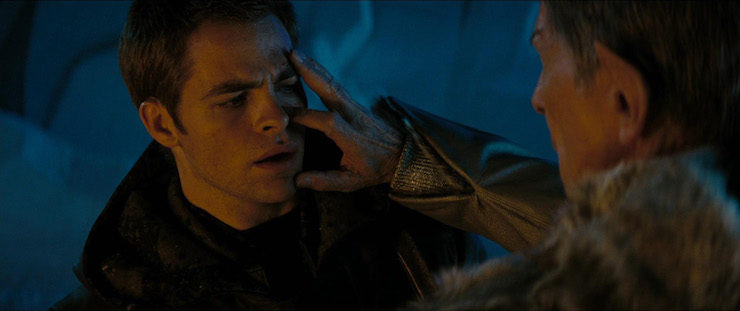
Ambassador Spock and Kirk proceed to the Starfleet base, where they encounter Scotty and Keenser, who mistake the duo for their relief. Apparently, at some point in the main timeline, Scotty created an equation for transwarp beaming that would allow them all to beam onto the Enterprise even though it’s at warp and far away. Sure.
The ambassador beams Kirk and Scotty to the Enterprise, with poor Keenser left behind. Scotty winds up in a series of water tubes that are present for no reason the script bothers to explain. (Apparently they’re turbines. Because that’s totally how a ship that travels faster than light would work.)
Spock has security bring Kirk and Scotty to the bridge, where Kirk refuses to tell Spock how they beamed aboard. Kirk then taunts Spock for not being emotional enough regarding what happened on Vulcan—mostly to get him to realize that he’s not emotionally fit for duty, something Ambassador Spock told Kirk to do. As with the little kids, it’s mentioning Amanda that sets him off. “Yo mama” really does work!
And since Pike made him first officer, and since he was never formally relieved of duty, Kirk is now in charge. He orders them to pursue the Narada. Chekov devises a method that will allow them to come out of warp near Titan, thus hiding them from Nero’s sensors within Saturn’s rings. Kirk and Spock beam onto the Narada from there—and to Kirk’s shock, Uhura gives Spock a goodbye kiss.
They beam aboard and immediately wind up in a firefight. Spock mind-melds with an unconscious Romulan to get the location of both the red matter and Pike. They board the Jellyfish, which recognizes Spock, making him realize that there’s more going on here than Kirk has let on.
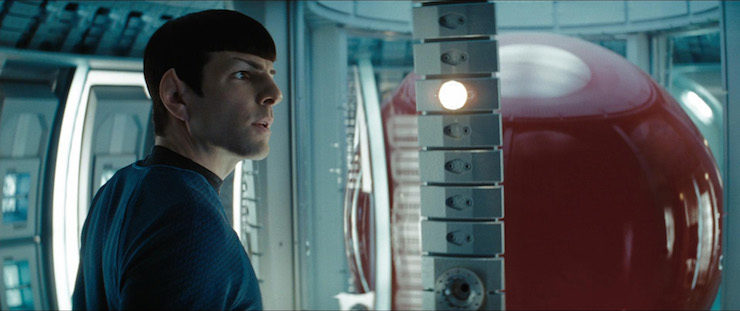
Spock takes off on the Jellyfish, while Kirk continues to search the Narada for Pike. Spock blasts his way out of the Narada and destroys the drill, thus saving Earth. Nero beats the crap out of Kirk, but then stops when he realizes what Spock has done. The Jellyfish goes to warp, and the Narada gives chase. Kirk kills Nero’s lieutenant, then rescues Pike.
The Jellyfish goes on a collision course with the Narada. Nero tries to destroy it, but the Enterprise shows up and takes out their missiles. Scotty beams Kirk, Spock, and Pike aboard. McCoy takes Pike to sickbay while Kirk and Spock offer Nero assistance. Nero refuses, so Kirk has Sulu fire on him, and the ship is destroyed and sucked into the singularity made by the red matter.
The Enterprise is almost sucked in as well, but Scotty ejects the warp core and detonates it, thus enabling them to clear the singularity’s gravitational field.
Much later, on Earth, Spock meets Ambassador Spock, and the latter encourages the former to remain in Starfleet, while the ambassador will help establish the New Vulcan colony.
Kirk is allowed to retain the rank of captain for no compellingly good reason, while Pike is promoted to admiral, and Kirk keeps the Enterprise. Spock signs on as his first officer, and the ship heads off into the wild black yonder.

Can’t we just reverse the polarity? Red matter is, er, something that can, uh, create singularities. Kinda. I think.
Fascinating. Ambassador Spock tried to save Romulus with an experimental Vulcan ship and red matter, but failed to do so. He also told Kirk that he couldn’t meet his counterpart due to grave consequences to the space-time continuum, but that was just to make sure that Kirk and Spock were able to work together in this timeline as they did in his.
I’m a doctor, not an escalator. McCoy’s nickname’s origin is finally explained, as is why only Kirk uses it. When he first meets Kirk, he says that all he had left after his divorce were his bones.
He’s only part of the medical staff initially, but is made chief medical officer when Dr. Puri is killed by Nero’s initial salvo.
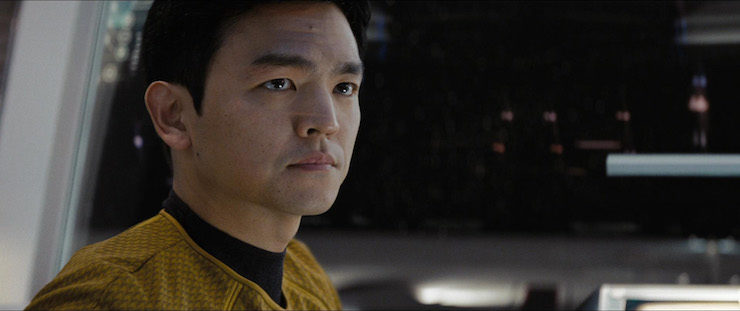
Ahead warp one, aye. Sulu forgets to take off the parking brake (basically) before they go to warp, which keeps the Enterprise from being destroyed in the first wave of Nero’s attack on Vulcan. He also does a nifty bit of flying to get the ship to come out of warp in Saturn’s rings.
He’s only flying the ship because the alpha shift helmsman has lungworm.
Hailing frequencies open. Uhura gets made alpha shift communications officer because the person assigned initially doesn’t know the difference between the Vulcan and Romulan languages. Her field of study is xenolinguistics, and she’s stunned when she discovers that Kirk actually knows what that word means.
I cannot change the laws of physics! Scotty has been exiled to Delta Vega because he attempted to prove his transwarp beaming theory on Admiral Archer’s prize beagle. He’s made chief engineer off camera.
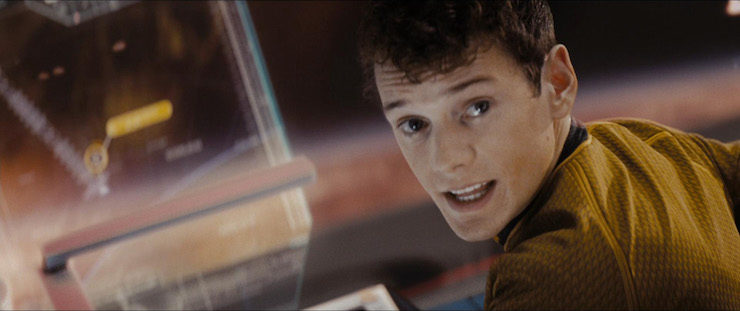
It’s a Russian invention. Chekov is only seventeen, and is described by Pike as a wiz. He comes up with the plan to fly into the solar system and is the one who beams up Kirk and Sulu while they’re falling.
Go put on a red shirt. Olson wears a red shirt and dies because he’s an idiot. The security guards do start a bar fight, but they all seem to survive.
No sex, please, we’re Starfleet. Kirk flirts with many women, most notably Uhura, spending most of the movie trying to find out her first name. (He only learns it when Spock says it out loud.) The only one he actually gets anywhere with is Gaila—who’s probably dead now, since she was assigned to one of the other ships in the fleet.
Spock and Uhura are also an item. As I’ve stated before, the seeds of this relationship can be found in several episodes of the original series, notably “The Man Trap,” “Who Mourns for Adonais?” “Is There in Truth No Beauty?” and most especially “Charlie X.”

Channel open.
“I am Spock.”
“Bullshit.”
–Ambassador Spock identifying himself and Kirk failing his disbelief roll.
Welcome aboard. The preexisting characters are entirely re-cast, with the half-exception of Spock, as Leonard Nimoy came out of retirement to reprise the role of Ambassador Spock. Chris Pine takes over the role of Kirk, with Zachary Quinto as the younger Spock, Karl Urban as McCoy, John Cho as Sulu, Simon Pegg as Scotty, Zoë Saldana as Uhura, Anton Yelchin as Chekov, Bruce Greenwood as Pike, Ben Cross as Sarek, and Winona Ryder as Amanda. All the above save for Cross and Ryder will return in Star Trek Into Darkness.
Eric Bana and Chris Hemsworth, who have respectively played the Hulk and Thor in Marvel movies, play Nero and George Kirk. Jennifer Morrison plays Winona, Faran Tahir plays Robau, and Greg Grunberg (a childhood friend of J.J. Abrams who appears in many of his productions) does the voice of Kirk’s stepfather; Grunberg will return as Commander Finnegan in Star Trek Beyond. Trek veteran W. Morgan Sheppard (“The Schizoid Man,” The Undiscovered Country) has an uncredited role as a member of the Vulcan Science Council.
In what turned out to be her final role, Majel Barrett reprises her longtime vocal portrayal of the Starfleet computers.
Trivial matters: This film takes place in an alternate timeline, possibly one created when Nero’s crew went back in time, or possibly an existing alternate time track that both the Narada and the Jellyfish traveled to when they went through the singularity. While other changes in history made by time travel have been reversed (“The City on the Edge of Forever,” “Yesterday’s Enterprise,” First Contact, “Past Tense“), the episodes “Mirror, Mirror” and “Parallels” established that there are alternate time tracks in which different decisions were made and remain permanent in those timelines.
Ambassador Spock is established as still being involved in Romulan politics in the 24th century, as seen in the “Unification” two-parter and “Face of the Enemy.”
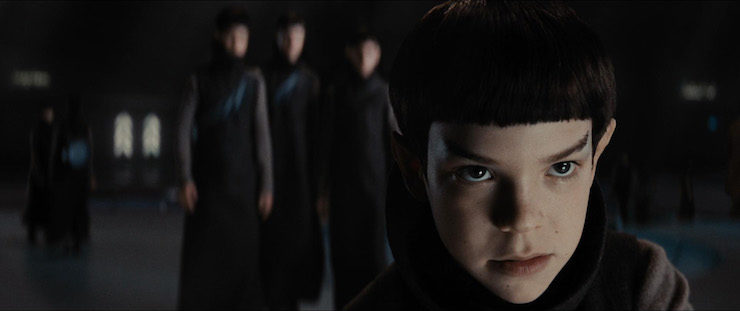
The scenes of Spock being tormented as a child were inspired by similar scenes in the animated episode “Yesteryear.” Spock refusing entry into the Vulcan Science Academy was mentioned in “Journey to Babel.” Kirk cheating to win the Kobayashi Maru test was established in The Wrath of Khan, though it wasn’t until this film that we learned that Spock programmed it (he said only in Wrath that he never took it).
This is the second time first names established in a Vonda McIntyre novel have become official onscreen: it was in Enterprise: The First Adventure that Kirk’s parents were established as having the first names of George and Winona, and they were used regularly in tie-in fiction going forward. The previous time was Sulu’s first name of Hikaru from The Entropy Effect being used in The Undiscovered Country.
In addition, Uhura’s first name of Nyota was established onscreen here, after first being used in William Rotsler’s Star Trek II: Biographies in 1982. It was one of several names suggested for Uhura, though it was the most popular one used in tie-in fiction; others include Penda in several works of fanfic and Samara in the FASA role-playing game.
The movie was novelized by Alan Dean Foster, who also novelized every episode of the animated series back in the 1970s. Foster was specifically requested by Bad Robot to do the job. IDW did a comic book adaptation by Tim Jones, Mike Johnson, David Messina, Claudia Balboni, & Gaetano Carlucci, though it wasn’t released until early 2010. Closer to the release of the film, IDW did three supplemental series: Countdown by Jones, Johnson, & Messina, which dramatized the events in the 24th-century that led to the destruction of Romulus and both Nero and Spock going through the black hole; Spock: Reflections by Scott & David Tipton, Messina, Federica Manfredi, & Arianna Florean, which focuses on Ambassador Spock’s life right up until he went into the black hole; and Nero by Jones, Johnson, & Messina, which details what Nero did during the 25 years between the Kelvin‘s destruction and Ambassador Spock’s arrival in the altered timeline.
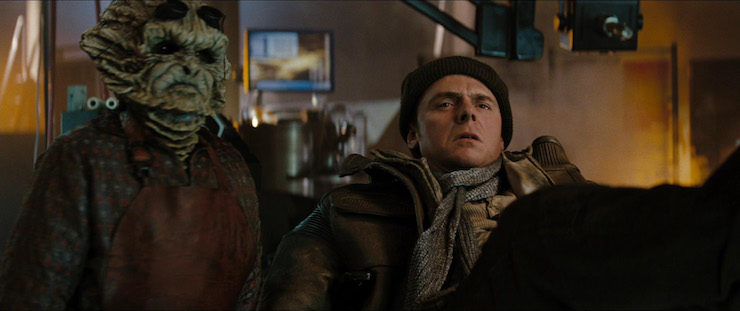
Admiral Archer’s prize beagle is a reference to the lead on the TV show Enterprise, who commanded the first starship with that name, and who had an affinity for beagles.
McCoy’s divorce, long considered a part of the character’s background but never seen on screen, is established here as the reason why McCoy joins Starfleet.
The planet where both Ambassador Spock and Kirk are exiled, and to which Scotty and Keenser are assigned, is named Delta Vega as a callback to the planet where Kirk was forced to kill Mitchell in “Where No Man Has Gone Before.”
Pike ends the movie in a wheelchair, a nod to his status in “The Menagerie” confined to a chair. He’ll be walking around again, albeit with a cane, in Star Trek Into Darkness.
The Klingon prison planet where an armada was destroyed by Nero was intended to be Rura Penthe, from The Undiscovered Country. A deleted scene established that Nero and his crew were imprisoned on Rura Penthe, which explains what they were doing for the 25 years between the Kelvin‘s destruction and Ambassador Spock’s arrival in the alternate timeline.
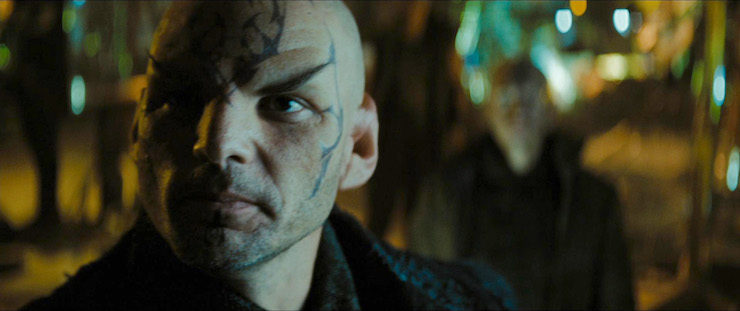
There was new Star Trek being produced for the screen consistently every year from 1986 (The Voyage Home) to 2005 (“These are the Voyages…,” the final episode of Enterprise). The four-year gap between the end of Enterprise and the release of this film was the longest drought between Trek productions since the five-year gap between “The Counter-Clock Incident,” the last animated episode in 1974, and The Motion Picture in 1979.
To boldly go. “Thrusters on full.” This movie served a very important function, and it’s one that it deserves ample credit for: it got the world at large interested in Star Trek again.
This is no small accomplishment. The decade prior to 2009 saw the only new Trek being produced being the following: Voyager, a flawed show that never captured the audience the way TNG did, nor had the critical praise that DS9 received; Enterprise, the only modern Trek show to fail in the marketplace; and the movie Nemesis, the swan song for the TNG cast that was a disaster both financially and artistically. Many folks were saying that the franchise needed a break because there was “too much” Star Trek, which is a stupid and wrong argument. There was actually less of Trek at this point, as from 1986-1999 there was always a TV show in production, and from 1993-99 that number was doubled, plus a movie every couple of years like clockwork. Meanwhile, Trek novels were regularly hitting the New York Times best-seller list, and merchandise sales were at an all-time high. Nobody started saying there was “too much” Trek in the 1990s.
No, the problem wasn’t too much Trek, the problem was too much bad Trek. And the audiences fell away like leaves in autumn.

Enter Bad Robot, who decides to reboot the original series for reasons passing understanding. I’ve never liked the idea of doing prequels, as Trek is at its best when it moves forward. If nothing else, there’s the technology issue—take out the warp drive and transporter, and the tech we saw in the original series is less sophisticated than that of a current big-city office building. To try to re-create that in the 21st century is just asking for trouble. Enterprise didn’t really manage it, and neither did this film. (Discovery faces the same issue.) And it’s telling that, as I said above, the last time they did a prequel it failed.
The biggest fear, though, is re-casting the roles. Desilu caught lightning in a bottle fifty years ago when they put William Shatner, Leonard Nimoy, and DeForest Kelley together, and there was no guarantee that that would happen again.
In that, at least, the fear turned out to be unjustified. Indeed, the acting is superlative throughout this film, which is one of the reasons why it’s so watchable. Chris Pine, Zachary Quinto, and especially the amazing Karl Urban simply nail their roles.
Pine has, in many ways, the easiest task, because his Kirk is the least like the one we’re familiar with, because he grew up without a father. (It wouldn’t be a J.J. Abrams production if one of the characters didn’t have major daddy issues.) In fact, he gives us a Kirk that embodies every stupid and not-really-true stereotype about the character: he’s constantly hitting on women (the mainline Kirk was a much more subtle flirt), he’s constantly flouting regulations (I’ve gone over that before, just read what I wrote here and here), and he’s overall, as my dear friend and colleague David Mack put it on the Captains of the Final Frontier documentary, “a punk—but a punk with potential.” I also have to confess to loving the fact that Kirk doesn’t win a single fistfight at any point in the film—the bar, the drill (where Sulu has to save his sorry ass), Spock attacking him on the bridge, on the Narada (he only wins that one by getting the lieutenant’s disruptor).
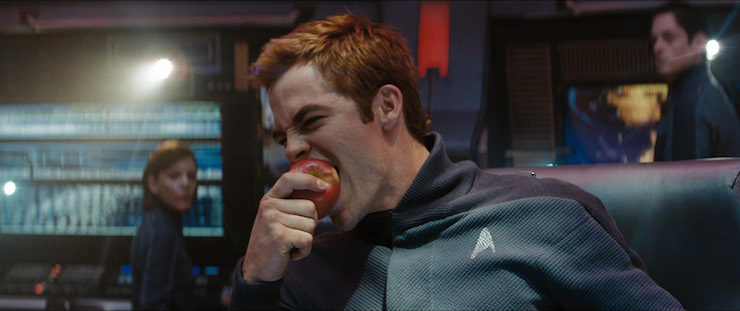
Quinto and Urban, though, have to channel their predecessors, Quinto with the added joy of having to do so with the original in the same movie. To their credit, they both pull it off perfectly. In particular, the conversation where Spock and McCoy discuss his response to the destruction of Vulcan and the removal of Kirk being a high point.
The movie is a fun, fast-moving romp, with a good character arc for both Kirk and Spock. It’s interesting, I haven’t actually watched this film since its 2009 release, and I had forgotten what a good job both the script and Quinto did with Spock’s war between logic and emotions, dramatizing the events of his youth from “Yesteryear” and “Journey to Babel” and doing a nice job of showing his difficulties, exacerbated by the destruction of Vulcan. And Kirk’s maturation actually works in the abstract.
Overall, the performances elevate the film considerably. Nobody ever went wrong casting John Cho or Anton Yelchin in anything, Simon Pegg is a delight as Scotty, Zoë Saldana is a fine Uhura, Bruce Greenwood brings gravitas to the role of Pike, and Faran Tahir, Chris Hemsworth, and Jennifer Morrison do excellent work on the tension-filled prologue (I wish I could say the same for Ben Cross and Winona Ryder, but they make almost no impression as Sarek and Amanda except to make us long for Mark Lenard and Jane Wyatt, the only re-cast roles where I felt that way). Plus, of course, you have Leonard Nimoy, who can not only put lipstick on a pig, but make the pig look good.
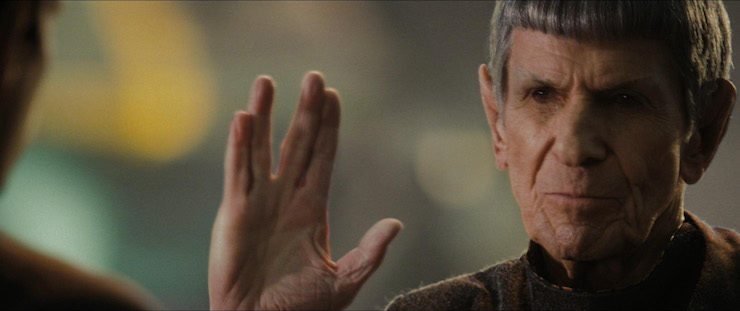
Unfortunately, this film needs all the elevating it can get, because while it succeeds in pacing and mostly in acting, everything else is a total mess. For starters, one person I didn’t list in the previous paragraph is Eric Bana. Nobody went right casting Bana in anything, and I have yet to see him give a performance where I actually gave a rat’s ass about the person he was playing. That streak remains intact with his lifeless performance as Nero, which does a great deal to suck the life out of the plot.
Not that the plot is anything to leap up in the air about. Nothing that happens in this movie makes any kind of sense. Why are cadets in uniform hanging out in a bar in Iowa? Pike just decides to recruit Kirk because Pike wrote about his father once and the kid (who was just in a bar fight) has good aptitude scores? If the shuttle Kirk and McCoy board is for people enlisting, why are the cadets in uniform (who must have already enlisted) on it? Most of the fleet is apparently in the Laurentian system, yet there are seven ships just sitting in dock without crews? Why does Pike make Kirk first officer? Why does the fleet never seem to actually leave the Laurentian system? Spock puts Kirk off onto a random planet that just happens to have Ambassador Spock and Scotty on it? Spock relieves himself of duty but then volunteers for a mission? And what the fuck is red matter anyhow?
Oh, and transwarp beaming? What the ever-loving hell?
Plus the contrivances to get everyone where they’re supposed to be are laughable. Having the CMO killed in the attack, paving the way for McCoy to take over, I can buy, ditto Sulu becoming helmsman because the alpha-shift guy got sick, but Uhura getting to be on the bridge because the communications officer doesn’t know languages? Scotty just magically becoming chief engineer because, I dunno, he’s just standing there, plus his predecessor was a total fucking moron? (Seriously, Olson may be the single stupidest person in the entire movie, possibly the entire franchise, and I include the Pakleds in that consideration.)
When everyone was gathered at Starfleet HQ at the end, I expected Kirk and Spock to be drummed out of the service—or at least demoted—for their idiotic and insubordinate behavior. (Leaving aside any other considerations, both of them committed assault on fellow officers: Kirk on the security guards, Spock on Kirk.) Instead, they were rewarded, and Kirk was given command even though he hadn’t even finished his tenure at the Academy yet. Right.
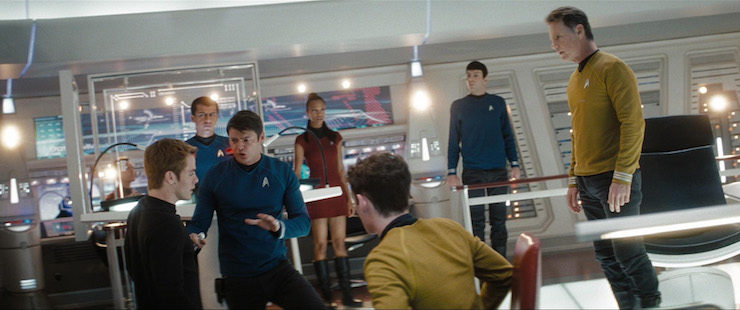
This film also has the worst set design in the history of Trek. We’ve got an engine room that looks like a brewery (mostly because that’s where they filmed those scenes, and who thought that was a good idea?), and we’ve got a bridge that looks like the Apple Store. And, of course, the lens flares blinding the viewer every five minutes. Seriously, the Enterprise bridge was one of the most perfect designs for a control center ever conceived, and J.J. Abrams managed to completely blow it.
It is, I admit, more fun than I expected to see new versions of the crew we all know and love on the big screen. The actors do superlative work with what they’re given, but what they’re given is simply dreadful.
Warp factor rating: 3
Next week: Star Trek Into Darkness
Keith R.A. DeCandido‘s latest work of fiction is “Live and On the Scene” in Nights of the Living Dead, edited by Jonathan Maberry & George A. Romero, an anthology of stories set around the events of Romero’s seminal 1968 zombie film.










